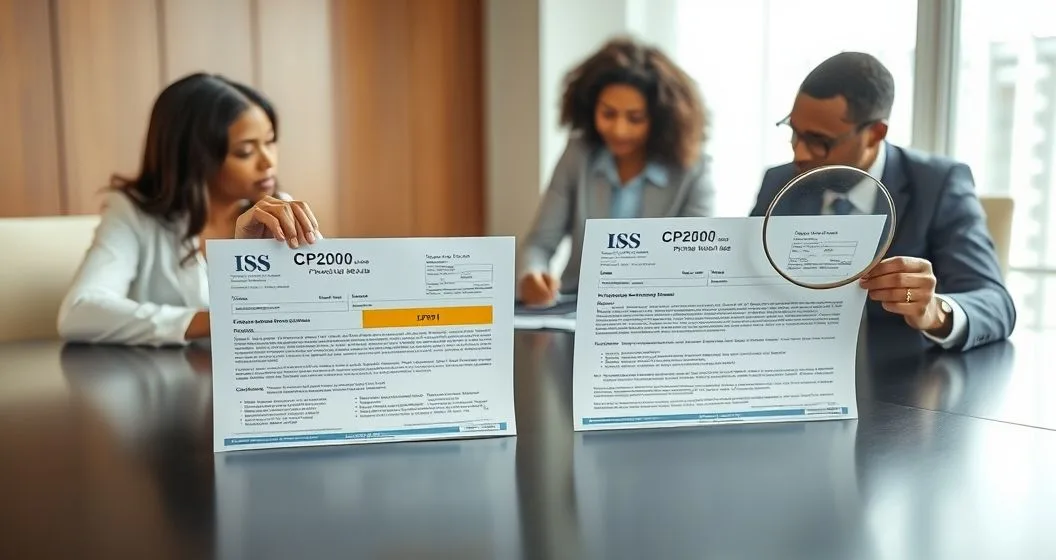When the IRS compares its third‑party data (employers, banks, payers) with your return, it may send a notice proposing adjustments. Two common letters are CP2000 and CP2501. Both need attention, but they serve slightly different roles and require different responses.
Why the IRS sends each notice
-
CP2000: Used primarily for income‑mismatch cases — when amounts on W‑2s, 1099s or brokerage statements don’t line up with what you reported. The letter usually includes the IRS’s proposed changes, a recalculated balance, and a response deadline (typically 30 days). See the IRS CP2000 page for details. (IRS: https://www.irs.gov/individuals/cp2000)
-
CP2501: Issued when the IRS has information that may lead to changes on your return. It can be informational or propose adjustments and sometimes asks for clarification or additional documents rather than showing a finalized tax due. Response instructions are on the IRS CP2501 page. (IRS: https://www.irs.gov/individuals/cp2501)
What you’ll typically see on the notice
- CP2000: A summary of the mismatch, line‑by‑line proposed adjustments, an amount the IRS believes you owe (or a refund change), and a deadline to agree or dispute.
- CP2501: A description of new information the IRS obtained and how it could affect your return; it may invite you to provide supporting documents or correct the return.
A quick real‑world distinction
In my practice I see CP2000s when payers failed to include 1099 income on a return (the letter will usually show proposed tax due). CP2501 commonly shows up when the IRS identifies potential credits or deductions that don’t match their records and wants clarification before finalizing changes.
Step‑by‑step response (practical checklist)
- Read the notice carefully and note the deadline. Most letters allow about 30 days to respond (check your specific notice). (IRS: https://www.irs.gov/individuals/cp2000)
- Compare the IRS information to your return and your records (W‑2s, 1099s, brokerage statements).
- If the IRS is correct, sign the response and pay or set up a payment plan. If you agree but can’t pay in full, include a request for installment options.
- If you disagree, gather supporting documents (pay stubs, corrected 1099s, bank statements) and send a clear explanation plus copies of evidence.
- If you need to change your return, file an amended return (Form 1040‑X) where appropriate and note if the IRS already proposed adjustments.
Helpful resources and internal guidance
- For a deeper walkthrough on steps and documentation, see our guide: Responding to a CP2000 Notice: Steps to Take.
- If you received a CP2000 for multiple income sources, this article is practical: Responding to a CP2000 When You Have Multiple 1099s and W‑2s.
Common mistakes to avoid
- Waiting to respond. Ignoring a notice can lead to collection actions or assessed penalties.
- Sending originals. Always send copies and keep your originals.
- Overreacting to language. These letters are usually proposed changes, not final demands; you have the chance to respond or dispute.
When to get professional help
If the proposed change is large, involves complex business, foreign income, or potential penalties, consult a CPA, enrolled agent, or tax attorney. In my experience, timely professional help reduces overpayments, avoids penalties, and clarifies documentation quickly.
FAQs (brief)
- Do I have to pay immediately? Not necessarily. If you agree, you can request payment options. If you disagree, respond with documentation and do not pay until the issue is resolved.
- Can the IRS assess penalties? Yes — if adjustments show underpayment and no reasonable cause, penalties and interest can apply. Respond promptly to reduce risk.
Sources and disclaimer
- IRS — CP2000: Notice of Proposed Adjustment: https://www.irs.gov/individuals/cp2000
- IRS — CP2501: Notice of Proposed Changes: https://www.irs.gov/individuals/cp2501
This article is educational and not personalized tax advice. For advice tailored to your situation, consult a qualified tax professional.



